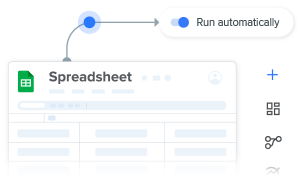Bank reconciliation is a crucial financial process for businesses to ensure that records match bank statements. In this post, we’ll explore how to prepare a bank reconciliation statement.
We will also discuss how to leverage the power of Sheetgo to automate this process. Let’s get right on it!
Automate your finances, reduce overhead
Your content goes here. Edit or remove this text inline or in the module Content settings. You can also style every aspect of this content in the module Design settings and even apply custom CSS to this text in the module Advanced settings.
8 steps to prepare a bank reconciliation statement
Why is it important to reconcile your bank statements?
Reconciling your bank statements is a crucial practice. Here are a few reasons why:
- Identify discrepancies – Detect differences between your records and the bank’s records, such as errors or unauthorized transactions.
- Prevent fraud – Regular reconciliation helps spot and prevent fraudulent activities by ensuring all transactions are legitimate.
- Manage cash flow – Keep track of outstanding checks and deposits in transit, providing a clear picture of your cash flow.
- Ensure accuracy – Verify that all financial transactions are accurately recorded, reducing the risk of financial misstatements.
- Improve decision-making – Accurate financial records provide a solid foundation for informed financial planning.
A bank reconciliation should be prepared periodically to ensure accurate financial records. This practice is essential for maintaining the financial health and integrity of your business.
Detailed steps to prepare a bank reconciliation statement
Preparing a bank reconciliation involves matching your company’s financial records with your bank statements to ensure consistency and identify any discrepancies.
Achieving this can take a lot of time and work, especially if you have to track down documents and information.

Here are the key steps to prepare a bank reconciliation statement:
- Collect bank statements – Obtain all relevant bank statements for the period you are reconciling.
- Gather internal financial records – Collect your company’s financial records, including the cash book and ledger.
- Compare balances – Check the opening balance on the bank statement against your records.
- Identify discrepancies – Look for any differences between the bank statement and your financial records, such as outstanding checks or deposits in transit.
- Adjust for discrepancies – Make necessary adjustments in your records for any outstanding items:
- Add deposits in transit
- Subtract outstanding checks
- Update records – Record any bank charges, interest, or errors identified during the reconciliation.
- Calculate adjusted balances – Ensure both your adjusted bank balance and your adjusted cash book balance match.
- Document reconciliation – Keep a record of the reconciliation process and any adjustments made for future reference.
By following this, you can effectively prepare a bank reconciliation statement and maintain accurate financial records. That being said, you’ll probably have to adapt this guide to suit your company’s needs.
Leveraging Sheetgo’s bank reconciliation module
Sheetgo is a powerful automation tool that can significantly streamline the bank reconciliation process. Its Finance solution includes a bank reconciliation module which automates the comparison of financial records with bank statements. In doing so, it reduces the time and effort required for manual reconciliation.
Using this module, you can automate data import from various sources, ensuring that your financial records are always up-to-date. The tool can help you compare transactions, identify discrepancies, and update your records accordingly.
Sheetgo integrates seamlessly with Google Workspace, allowing you to leverage its full potential in a familiar environment. With its customizable workflows, you can tailor the reconciliation process to fit your specific needs, ensuring a smooth and efficient operation.
By automating the reconciliation process with Sheetgo, businesses can focus more on strategic financial planning and less on the manual tasks.

Reconciliation with Sheetgo, pros and cons
Consider an accounting team at a mid-sized company that needs to perform bank reconciliation on a monthly basis. This task is essential to ensure that their financial records are accurate and up-to-date.
A manual reconciliation process can have a lot of drawbacks. But fortunately Sheetgo solves most of them.
Let’s look at some of the challenges faced when doing reconciliation the good old way:
| Manual reconciliation | Using Sheetgo |
| Time-consuming process to manually compare each transaction | Automated data import and comparison save time |
| High risk of human error when matching records | Reduced errors through automated processes |
| Difficulty in tracking outstanding items like checks and deposits | Automatic updates for outstanding items |
| Manual adjustments needed for bank charges and interest | Automatic adjustments and updates |
| Inconsistent record-keeping due to varying reconciliation methods | Consistent workflows with customizable templates |
| Lack of integration with other tools | Seamless integration with Google Workspace |
By using Sheetgo, this accounting team can automate their monthly bank reconciliation, ensuring a more efficient and accurate process.
The time saved can be redirected towards more strategic financial planning and analysis, ultimately benefiting the overall financial health of the company.
Conclusion
Now you know the purpose of bank reconciliation. It’s vital to maintain accurate financial records and ensure the financial health of a business. Manual reconciliation can be time-consuming and error-prone, but tools like Sheetgo can automate and streamline this process.
By using Sheetgo, businesses can automate data import, comparison, and adjustments, reducing the risk of errors and saving valuable time. This allows accounting teams to focus on strategic financial planning rather than manual data entry.
Check out Sheetgo finance temaplates and enhance your financial management processes today.




